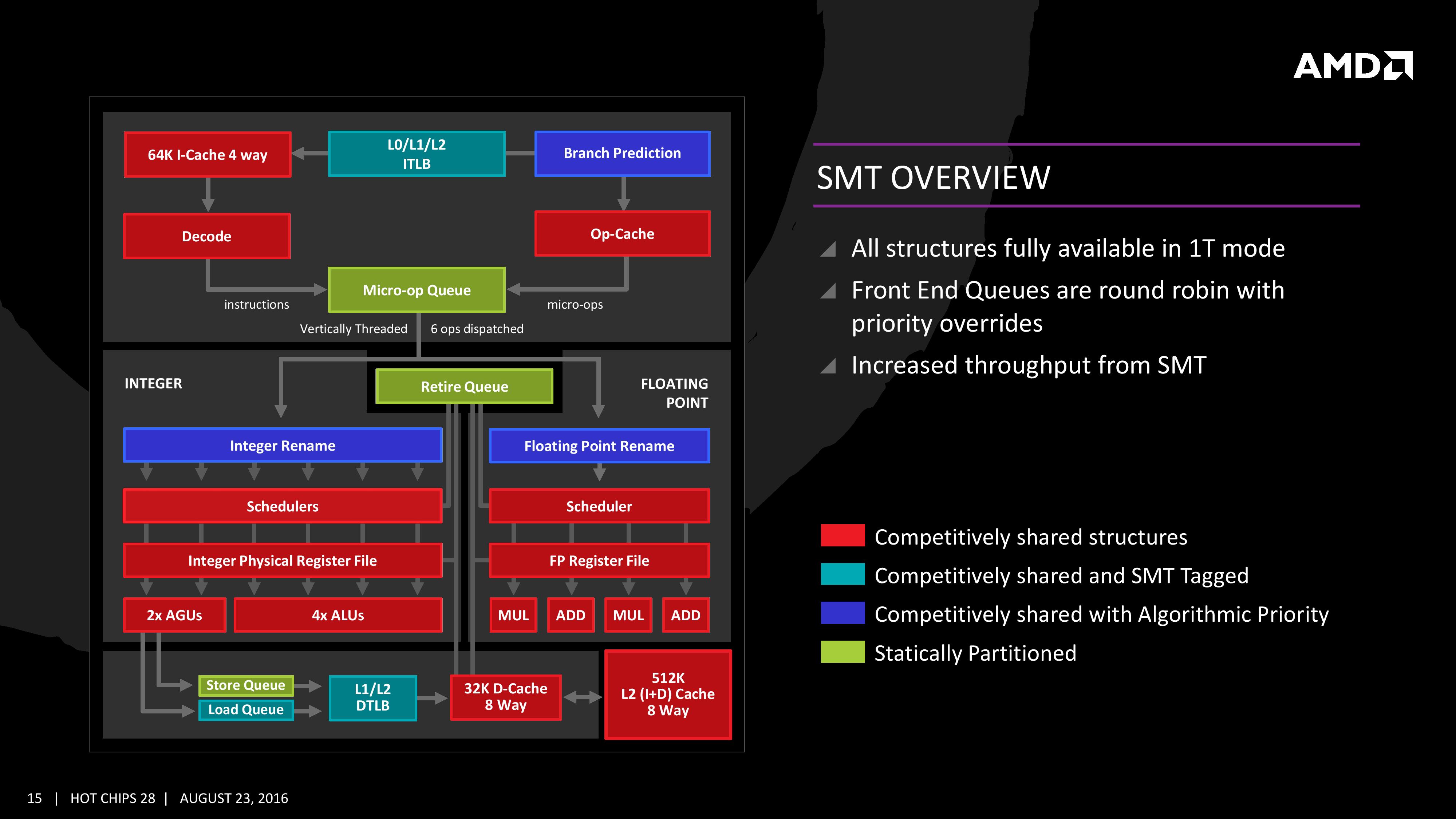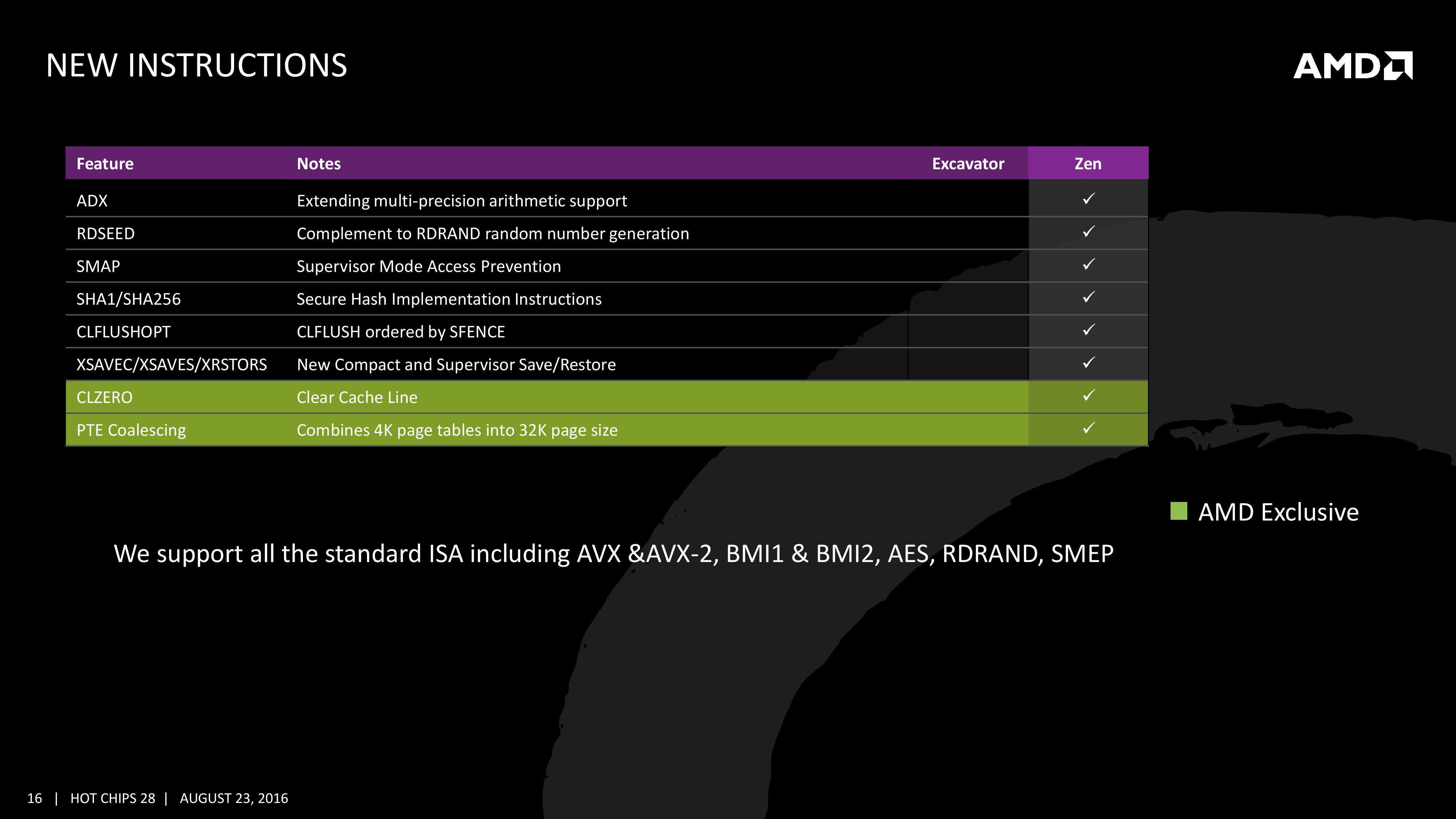AMD Zen Microarchiture Part 2: Extracting Instruction-Level Parallelism
by Ian Cutress on August 23, 2016 8:45 PM EST- Posted in
- CPUs
- AMD
- x86
- Zen
- Microarchitecture
Simultaneous MultiThreading (SMT)
Zen will be AMD’s first foray into a true simultaneous multithreading structure, and certain parts of the core will act differently depending on their implementation. There are many ways to manage threads, particularly to avoid stalls where one thread is blocking another that ends in the system hanging or crashing. The drivers that communicate with the OS also have to make sure they can distinguish between threads running on new cores or when a core is already occupied – to achieve maximum throughput then four threads should be across two cores, but for efficiency where speed isn’t a factor, perhaps power gating/clock gating half the cores in a CCX is a good idea.
There are a number of ways that AMD will deal with thread management. The basic way is time slicing, and giving each thread an equal share of the pie. This is not always the best policy, especially when you have one performance dominant thread, or one thread that creates a lot of stalls, or a thread where latency is vital. In some methodologies the importance of a thread can be tagged or determined, and this is what we get here, though for some of the structures in the core it has to revert to a basic model.
With each thread, AMD performs internal analysis on the data stream for each to see which thread has algorithmic priority. This means that certain threads will require more resources, or that a branch miss needs to be prioritized to avoid long stall delays. The elements in blue (Branch Prediction, INT/FP Rename) operate on this methodology.
A thread can also be tagged with higher priority. This is important for latency sensitive operations, such as a touch-screen input or immediate user input elements required. The Translation Lookaside Buffers work in this way, to prioritize looking for recent virtual memory address translations. The Load Queue is similarly enabled this way, as typically low latency workloads require data as soon as possible, so the load queue is perfect for this.
Certain parts of the core are statically partitioned, giving each thread an equal timing. This is implemented mostly for anything that is typically processed in-order, such as anything coming out of the micro-op queue, the retire queue and the store queue.
The rest of the core is competitive, meaning that if a thread demands more resources it will try to get there first if there is space to do so each cycle.
New Instructions
AMD has a couple of tricks up its sleeve for Zen. Along with including the standard ISA, there are a few new custom instructions that are AMD only.
Some of the new commands are linked with ones that Intel already uses, such as RDSEED for random number generation, or SHA1/SHA256 for cryptography. The two new instructions are CLZERO and PTE Coalescing.
The first, CLZERO, is aimed to clear a cache line and is more aimed at the data center and HPC crowds. This allows a thread to clear a poisoned cache line atomically (in one cycle) in preparation for zero data structures. It also allows a level of repeatability when the cache line is filled with expected data. CLZERO support will be determined by a CPUID bit.
PTE (Page Table Entry) Coalescing is the ability to combine small 4K page tables into 32K page tables, and is a software transparent implementation. This is useful for reducing the number of entries in the TLBs and the queues, but requires certain criteria of the data to be used within the branch predictor to be met.












106 Comments
View All Comments
Bulat Ziganshin - Wednesday, August 24, 2016 - link
I think it's obvious from number of ALUs that 40% improvement is for scalar single-thread code that greartly bemnefits from access to all 4 integer ALUs. Of course, it will get the same benefit fro any code running up to 8 threads (for 8-core Zen). But anyway it should be slower than KabyLake since Intel spent much more time optimizng their CPUsFor m/t execution, improvements will be much smaller, 10-20%, i think. Plus, 8-core CPU will probably run at smaller frequency than 4-core Buldozers or 4-core KabyLake. AFAIK, even Intel 8c-ore CPUs run at 3.2 GHz only, and it's after many years of power optimization. We also know that *selected* Zen cpus run at 3.2 GHz in benchamrks. So, i expect either < 3 GHz frequency, or 200 Wt power budget
atomsymbol - Wednesday, August 24, 2016 - link
"For m/t execution, improvements will be much smaller, 10-20%, i think."There are bottlenecks in Bulldozer-family when a module is running two threads. An improvement of 40% for m/t Zen execution in respect to Bulldozer m/t execution is possible. It is a question of what the baseline of measurement is.
Bulat Ziganshin - Wednesday, August 24, 2016 - link
M/t execution in Bulldozer already can use all 4 INT alus, so i think that 40% IPC improvement is impossible. In other words, if s/t IPC improved by 40% by moving from 2 alu to 4 alu arrangement, m/t performance that keeps the same 4 alu arrangement, hardly can be improved by more than 20%looncraz - Wednesday, August 24, 2016 - link
IPC is NOT MT, it is ST only.IPC is per-core, per-thread, per-clock, instruction retire rate... which generally equates to performance per clock per core per thread.
Bulat Ziganshin - Thursday, August 25, 2016 - link
you can measure instruction per cycles for a thread, 3 threads, core, cpu or anything else. what's a problem??My point is that s/t speed on Zen is improved much more than m/t speed, compared to last in Bulldozer family. So, they advertized improvement in s/t speed, that is 40%. And m/t improvement is much less since it still the same 4 alus (although many other parts become wider).
atomsymbol - Thursday, August 25, 2016 - link
AMD presentation was comparing Zen to Broadwell in a m/t workload with all CPU cores utilized.From
http://www.cpu-world.com/Compare/528/AMD_A10-Serie...
you can compute that the Blender-specific speedup of Zen over a previous AMD design is about 100/38.8=2.57
Bulat Ziganshin - Thursday, August 25, 2016 - link
Can you compute IPC improvement, that we are discussing here?looncraz - Thursday, August 25, 2016 - link
Except you're absolutely wrong, the performance increases will be much higher for MT than ST.Bulldozer was hindered by the module design, so you had poor MT scaling - not an issue with Zen. On top of that, Zen has SMT, which should add another 20% or so more MT performance for the same number of cores.
A 40% ST improvement for Zen could easily mean a 100% performance improvement for MT.
Bulat Ziganshin - Saturday, August 27, 2016 - link
It's not "on top of that". Zen is pretty simple Bulldozer modification that fianlly allowed to use all 4 scalar ALUs in the module for the single thread. It's why scalar s/t perfroamnce should be 40% faster. OTOH, two threads in the module still share those 4 scalar ALUs as before, so m/t perfromance cannot improve much. On top of that, module was renamed to core. So, there are 2x more cores now and of course m/t performance of entire CPU will be 2x higherNenad - Thursday, September 8, 2016 - link
It is possible that AMD already count SMT (hyperthreading) into those 40%.Their slide which states "40% IPC Performance Uplift" also lists all things that AMD used to achieve those 40%...and first among those listed things is "Two threads per core". So if AMD already counted that into their 40% IPC uplift, then 'real' IPC improvement (for single thread) would be much lower.